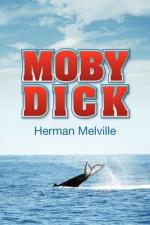“Ka-la! Koo-loo!” howled Queequeg, as if smacking his lips over a mouthful of Grenadier’s steak. And thus with oars and yells the keels cut the sea. Meanwhile, Stubb, retaining his place in the van, still encouraged his men to the onset, all the while puffing the smoke from his mouth. Like desperadoes they tugged and they strained, till the welcome cry was heard—“Stand up, Tashtego!—give it to him!” The harpoon was hurled. “Stern all!” The oarsmen backed water; the same moment something went hot and hissing along every one of their wrists. It was the magical line. An instant before, Stubb had swiftly caught two additional turns with it round the loggerhead, whence, by reason of its increased rapid circlings, a hempen blue smoke now jetted up and mingled with the steady fumes from his pipe. As the line passed round and round the loggerhead; so also, just before reaching that point, it blisteringly passed through and through both of Stubb’s hands, from which the hand-cloths, or squares of quilted canvas sometimes worn at these times, had accidentally dropped. It was like holding an enemy’s sharp two-edged sword by the blade, and that enemy all the time striving to wrest it out of your clutch.
“Wet the line! wet the line!” cried Stubb to the tub oarsman (him seated by the tub) who, snatching off his hat, dashed the sea-water into it.* More turns were taken, so that the line began holding its place. The boat now flew through the boiling water like a shark all fins. Stubb and Tashtego here changed places—stem for stern—a staggering business truly in that rocking commotion.
Partly to show the indispensableness of this act, it may here be stated, that, in the old Dutch fishery, a mop was used to dash the running line with water; in many other ships, a wooden piggin, or bailer, is set apart for that purpose. Your hat, however, is the most convenient.
From the vibrating line extending the entire length of the upper part of the boat, and from its now being more tight than a harpstring, you would have thought the craft had two keels—one cleaving the water, the other the air—as the boat churned on through both opposing elements at once. A continual cascade played at the bows; a ceaseless whirling eddy in her wake; and, at the slightest motion from within, even but of a little finger, the vibrating, cracking craft canted over her spasmodic gunwale into the sea. Thus they rushed; each man with might and main clinging to his seat, to prevent being tossed to the foam; and the tall form of Tashtego at the steering oar crouching almost double, in order to bring down his centre of gravity. Whole Atlantics and Pacifics seemed passed as they shot on their way, till at length the whale somewhat slackened his flight.
“Haul in—haul in!” cried Stubb to the bowsman! and, facing round towards the whale, all hands began pulling the boat up to him, while yet the boat was being towed on. Soon ranging up by his flank, Stubb, firmly planting his knee in the clumsy cleat, darted dart after dart into the flying fish; at the word of command, the boat alternately sterning out of the way of the whale’s horrible wallow, and then ranging up for another fling.




